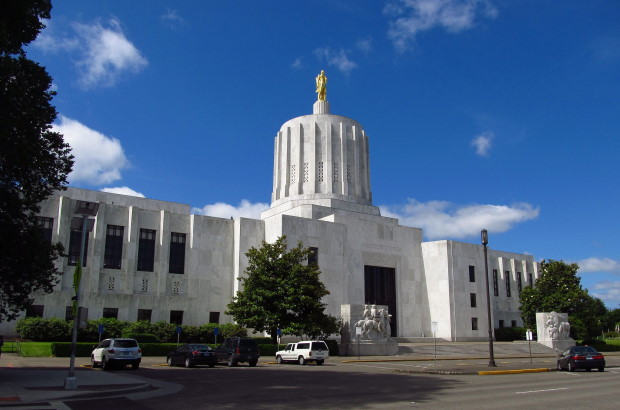What's ahead for climate action in Salem?
No corner of our state was left untouched by climate-fueled storms and harms last year.

![]() Cities play a unique and critical role in reducing greenhouse gas emissions. Half the world lives in cities and over 80% of Americans do. Cities are responsible for 70% of global carbon emissions. Hence, strategies to reduce urban emissions are essential to solving the climate crisis and cities will play a vital role in achieving the carbon reduction targets required to keep the earth at a viable temperature. In this pathway, we chronicle how American cities are reducing climate pollution by investing in energy efficiency, local distributed renewable energy, electricity grid innovation, and clean transportation.
Cities play a unique and critical role in reducing greenhouse gas emissions. Half the world lives in cities and over 80% of Americans do. Cities are responsible for 70% of global carbon emissions. Hence, strategies to reduce urban emissions are essential to solving the climate crisis and cities will play a vital role in achieving the carbon reduction targets required to keep the earth at a viable temperature. In this pathway, we chronicle how American cities are reducing climate pollution by investing in energy efficiency, local distributed renewable energy, electricity grid innovation, and clean transportation.
What are the top strategies for cities to reduce greenhouse gas emissions?
Cities have policy and programmatic tools to reduce greenhouse gas emissions, especially in the areas of capping emissions, energy supply, building energy efficiency, and transportation. Tokyo, Japan and Shenzhen, China pioneered local systems to cap and price carbon emissions. Berlin, Germany and Minneapolis, MN are partnering with their energy utilities to clean up their electricity supplies, while Sonoma County, CA and Westchester County, NY are negotiating for cleaner, cheaper electricity on behalf of their residents.
Lancaster, CA requires that all new rooftops come equipped with solar panels or have access to solar energy. Fifteen cities and one county across the U.S. require that commercial building owners report their energy use on an annual basis, as a tool to increase market awareness and valuation of building energy performance.
Policies that encourage urban density with robust transportation options and affordable housing set the framework for low-carbon communities. Finally, electrification of vehicles, buses, trucks, and equipment – especially in regions that have low- or no-carbon electricity—can be a crucial strategy to reduce the use of oil in transportation.
What is carbon neutrality, and how do cities achieve it?
A city on the path to carbon neutrality is one that aims to power its buildings, transportation, and other energy-consuming activities without fossil fuels. In the words of the Carbon Neutral Cities Alliance, achieving carbon neutrality “requires transformative rather than incremental approaches,” with a roadmap for long-term and deep reductions in the building, energy, and transportation sectors.
In 2011 the City of Seattle commissioned a study of potential pathways to achieve its carbon neutrality goal, and in 2015 the Carbon Neutral Cities Alliance published a framework for cities on long-term deep carbon reduction planning.
It is essential that cities consider how prospective strategies add up to overall climate goals, how to achieve those goals in partnership with the private and nonprofit sector, and how to fund implementation in context of budget constraints. The Urban Clean Energy Revolution provides a detailed compendium of best practices in these areas. The climate crisis requires that urban governments and their partners embrace these actions at a greater scale and with more urgency than ever before.

No corner of our state was left untouched by climate-fueled storms and harms last year.

The Eugene, OR city council voted to start studying whether to require all new-constructed commercial and residential buildings be electric only.

Despite a recent Executive Order on climate action by outgoing Seattle mayor, Jenny Durkan, Seattle is still behind on its goals. Deepa Sivirajan has a few recommendations for Mayor-Elect Bruce Harrell on making climate central to his future governance.

We’re used to thinking of transportation as the big source of greenhouse gas emissions. But while they don't move, buildings still emit carbon and air pollution.

23 days. That’s how much time is left in the legislative session in Salem.

We need your help now to get these important bills across the finish line this session and get more EVs on our roads. But the work won’t stop there.

Washington State doubles down on climate action, red meat lies, and building electrification on the rise

On April 20th Tacoma set a path forward for clean and safe buildings in their city.

Multnomah County Board of Commissioners unanimously approved a resolution ensuring all new county-owned buildings—including libraries, courthouses, and community centers—are built to be fossil-free and utilize 100% clean and renewable energy.

We're pleased to report forward progress on two of our high-priority climate bills.
Join our email list to learn about what we do and how to get involved.
There are no upcoming events posted at this time.
No corner of our state was left untouched by climate-fueled storms and harms last year.
We’re used to thinking of transportation as the big source of greenhouse gas emissions.
23 days. That’s how much time is left in the legislative session in Salem.